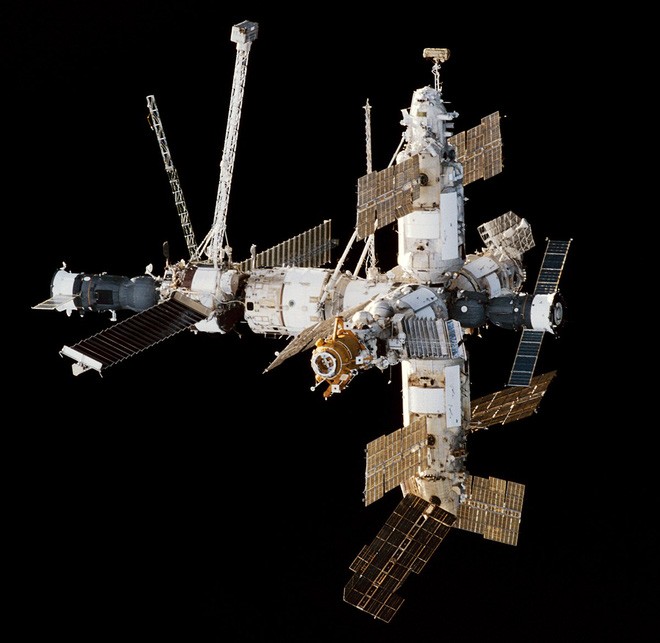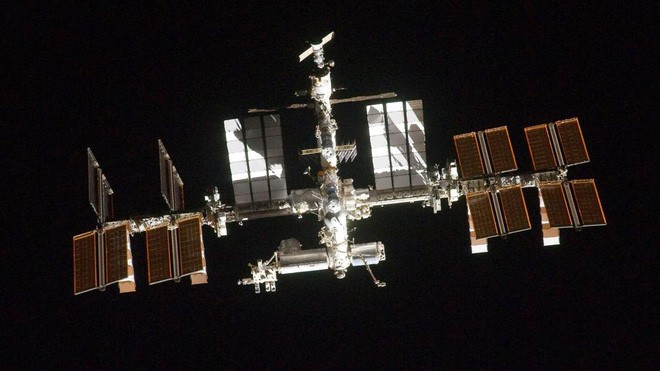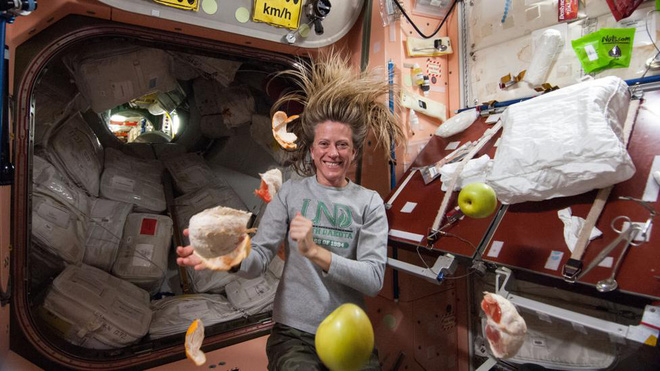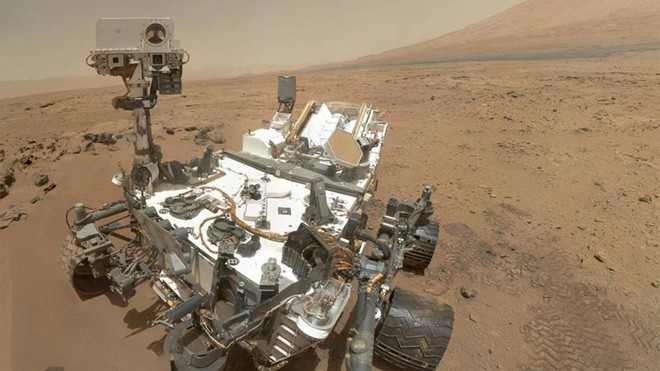How clean are astronauts keeping the space station?
In 1998, after 12 years of orbit, Russia's Mir space station began showing symptoms of failure: frequent power failures, poor computers, leaking air-conditioning systems. To better understand the cause of this situation, the crew began studying the types of microorganisms that exist on the station and they were all amazed at the results.
Astronauts check inside a panel and they find balloon-sized water balls of water. After analysis, it was discovered that the inside of this cloudy water was full of bacteria, fungi and dust mites. More worrying is that the creature populations are attacking the station's rubber that seals the windows and acid-producing bugs are eating the power cable slowly.

Mir Station.
When the Mir space station was launched, it was almost in aseptic condition, each assembled in a closed room by engineers wearing protective clothing and masks. The microorganisms that appeared later were brought by the crew.
We share life and body with microorganisms. From bacteria in the intestines to dead skin-eating mites, science estimates that more than half of the cells in our bodies do not belong to humans. Most of these microorganisms are not only harmless but also necessary, they assist us in digesting food and preventing disease. Wherever we go, the microorganisms follow and, like humans, they have the ability to adapt to life in space.
"Space is a harsh environment not just for people," says Christine Moissl-Eichinger. She is the author of a scientific report on the study of the microbiota at the International Space Station. "Space flights put pressure on the crew and we wondered if there was any pressure from the microbiota and there was a negative reaction . "
The Moissl-Eichinger scientific report appears just in time for the 20th anniversary of the International Space Station.

In the context that Covid-19 made everyone afraid of bacteria and viruses clinging to surfaces, people posed an interesting question: how to keep the space station clean?
Experiencing from the case of Mir station, biologists are always worried and wondering if there are other creatures living on the station, especially the microorganisms that harm the station and the crew.
"Due to the adaptation to the special situation in space, we hope to find differences in the genetic structure or compound composition of the microbial community," Moissl-Eichinger said. She is from Graz Medical University in Austria.
Scientists have determined that within the International Space Station there are about 55 different types of microorganisms inhabiting. This includes bacteria, fungi, molds, protozoa and viruses. Despite the lack of gravity, these microorganisms still adapt well to their surroundings.
"They are not resistant to antibiotics or possess traits that are harmful to humans , " Moissl-Eichinger said. "But we found they have adapted to all metal surfaces . "
To keep the space station clean as well as preventing the growth of microbial populations, the crew must embark on sanitation. Each week, the astronauts clean the surface of the space station with antibacterial towels and use a vacuum cleaner to clean up the floating debris. They also clean daily to keep the kitchen area clean and prevent mold and exercise equipment from becoming moldy.
"We rely on the astronauts to partially handle the cleaning , " Christophe Laseur said. He is the head of life support systems research at the European Space Ministry (ESA). "But at the same time, we also rely on technology to filter the air and keep the water clean . "
Lessons learned from the Mir Space Station have been applied to the design and operation of the International Space Station. For example, the environment is kept drier to prevent organisms from growing and there is always a breeze that pushes dust into the air filtration system.
"The only difference between the Earth and the space station is that dust will not settle but accumulate in the vents," Lasseur said. "But at the same time, small objects like pencils or glasses will be blown to the vent . " In fact, anything that is not attached to a wall is likely to be blown away.

The case of the International Station has proved that humans can coexist with microorganisms in space without having to face many negative effects. What scientists worry now is what will happen if we leave the low orbit of the Earth and go to the moon or Mars.
"The International Space Station is currently below the Van Allen radiation belt, so radiation exposure is reduced , " Lasseur said. "If we cross this belt, the radiation will increase and the evolutionary ability of microorganisms [through mutations] could become faster . "
NASA is currently developing the next space station to launch into space. The station is called Gateway and is planned to be a lab orbiting the moon. As expected, the astronauts will live on it for a few weeks. They will then leave it blank for months until the next time the astronaut arrives.
"We have to make sure that when the astronauts leave the station, they don't leave an ideal environment for the growth of microorganisms . " Lasseur said. "Because the consequences of this can be very serious . "
Scientists are also trying to predict what will happen when astronauts and the microbiota on their bodies together land on Mars' surface for the first time.
Everything that people sent to Mars is thoroughly cleaned. Including self-propelled vehicles that ESA is expected to send to Mars later this year. This car was assembled in the UK's cleanest room by engineers wearing special underwear, full body protection, face masks and two pairs of gloves. The car aims to find life once or existing on Mars. For this purpose, it is very important to ensure that the vehicle does not carry any life from Earth.

But when humans arrive on Mars, they won't be so clean. Removing all microorganisms on astronauts is impossible and will definitely be lethal. How do we not pollute the pristine environment of Mars or confuse the creatures we bring into alien life?
"It is true that we have a lot of microorganisms on our bodies but astronauts will not be naked on Mars," said Gerhard Kminek, planetary security officer at ESA. "Astronauts will wear space suits to keep them alive and prevent microorganisms from getting out . "
The real challenge is to prevent microorganisms from clinging to outer space to contaminate the environment of Mars. A team of researchers has been working on this problem and is expected to announce feasible measures by the end of this year to protect Mars from human impact.
A bigger concern is the problem of bringing Mars microorganisms back to Earth. A mission to recover soil and rock from Mars is currently planned and it is likely that the samples collected will contain life inside.
Of course, based on science fiction movies, any alien creature is very deadly and one needs to be careful. Although the latest research confirms that there are no dangerous organisms on the International Space Station, the ability to understand the evolution of microorganisms is necessary to ensure the safety of astronauts. gia.
"When the crew returns, if we discover something strange in their microbiota, we can determine whether its origin comes from Mars or from space flights , " Kminek said conservatively.
Microbiologists, meanwhile, are looking forward to studying a completely different kind of specimen. 50 years ago, the crew of the Apollo ship left 96 bags of human waste on the moon. In the next decade, when humans return to that planet, NASA hopes they can recover a few bags to see if the bacteria in it are still alive. If they were alive, this would mark another small step in the understanding of human microflora.
According to the BBC
You should read it
- The 7 largest objects people ever launched into space
- There will soon be a 'green vegetable garden' on the International Space Station (ISS)
- 7 interesting facts about NASA authority
- What's special about supercomputers that survived 1 year on ISS International Space Station?
- Why does SpaceX send the deadly virus to the International Space Station?
- Impressive image: ISS International Space Station flies over the Sun.
- Beautiful Earth video at night is filmed from the International Space Station ISS
- NASA recycles urine and sweat of crew on ISS space station 98%
May be interested
- How do astronauts breathe in space?
 engineers have had to come up with some unique ways to create oxygen in the vacuum of space. here's how astronauts breathe in space.
engineers have had to come up with some unique ways to create oxygen in the vacuum of space. here's how astronauts breathe in space. - Can astronauts go to catch Pokemon?
 we play pokemon go on the ground is obvious, so can astronauts play this virtual reality game in the universe?
we play pokemon go on the ground is obvious, so can astronauts play this virtual reality game in the universe? - Stunned with images of three major storms in the ocean recorded by the ISS space station
 seen from the iss space station, the magnificent storms, but hidden within them, are terrifying power that can cause catastrophes for humans.
seen from the iss space station, the magnificent storms, but hidden within them, are terrifying power that can cause catastrophes for humans. - The Russian astronaut announces to find extraterrestrial life on the ISS Space Station
 the russian astronaut announced finding extraterrestrial life on the iss space station, only this discovery is a little less interesting than the hollywood movies we still see.
the russian astronaut announced finding extraterrestrial life on the iss space station, only this discovery is a little less interesting than the hollywood movies we still see. - Chinese scientists revealed plans for the Laser Station to clean up the garbage
 there have been several suggestions for removing space junk, such as garbage collection, crushing garbage or bombarding them from the earth. however, this new idea can be arguably the most impressive and effective.
there have been several suggestions for removing space junk, such as garbage collection, crushing garbage or bombarding them from the earth. however, this new idea can be arguably the most impressive and effective. - What's special about supercomputers that survived 1 year on ISS International Space Station?
 a year ago, hewlett packard enterprise (hp) sent their hpe spaceborne computer to the iss international space station to check if it could survive in harsh environments.
a year ago, hewlett packard enterprise (hp) sent their hpe spaceborne computer to the iss international space station to check if it could survive in harsh environments. - Please watch the first 8K video filmed in space
 recently, nasa shared the first 8k video footage shot in space and in the iss space station on its front page. if you have a tv or devices that support 8k resolution, you will have the opportunity to get closer to the experience in the space through this 3-minute video.
recently, nasa shared the first 8k video footage shot in space and in the iss space station on its front page. if you have a tv or devices that support 8k resolution, you will have the opportunity to get closer to the experience in the space through this 3-minute video. - SpaceX's Crew Dragon spacecraft successfully assembled with the ISS station, completely automated
 this trip of spacex was a great success.
this trip of spacex was a great success. - There will soon be a 'green vegetable garden' on the International Space Station (ISS)
 green vegetables can not only grow under space conditions, but can produce enough nutrients not inferior to those grown on earth.
green vegetables can not only grow under space conditions, but can produce enough nutrients not inferior to those grown on earth. - How do astronauts drink coffee in space?
 just like us, astronauts working in space enjoy a cup of coffee every now and then.
just like us, astronauts working in space enjoy a cup of coffee every now and then.










 How did the world's most powerful supercomputer help science fight the Covid-19 epidemic?
How did the world's most powerful supercomputer help science fight the Covid-19 epidemic? Detecting that employees were positive for Covid-19, NASA had to lay off nearly 17,000 employees to avoid the outbreak
Detecting that employees were positive for Covid-19, NASA had to lay off nearly 17,000 employees to avoid the outbreak Thanks to the broken antenna, the scientists solved the 58-year secret of physics
Thanks to the broken antenna, the scientists solved the 58-year secret of physics Expert: There will be no lifelong immunity to SARS-CoV-2
Expert: There will be no lifelong immunity to SARS-CoV-2 365 years ago, did the scientist Newton return to his hometown to avoid the epidemic and what great achievements did science make?
365 years ago, did the scientist Newton return to his hometown to avoid the epidemic and what great achievements did science make? The air on the plane is not as easy to spread the flu virus as you think, sometimes it is less safe to ride the bus
The air on the plane is not as easy to spread the flu virus as you think, sometimes it is less safe to ride the bus